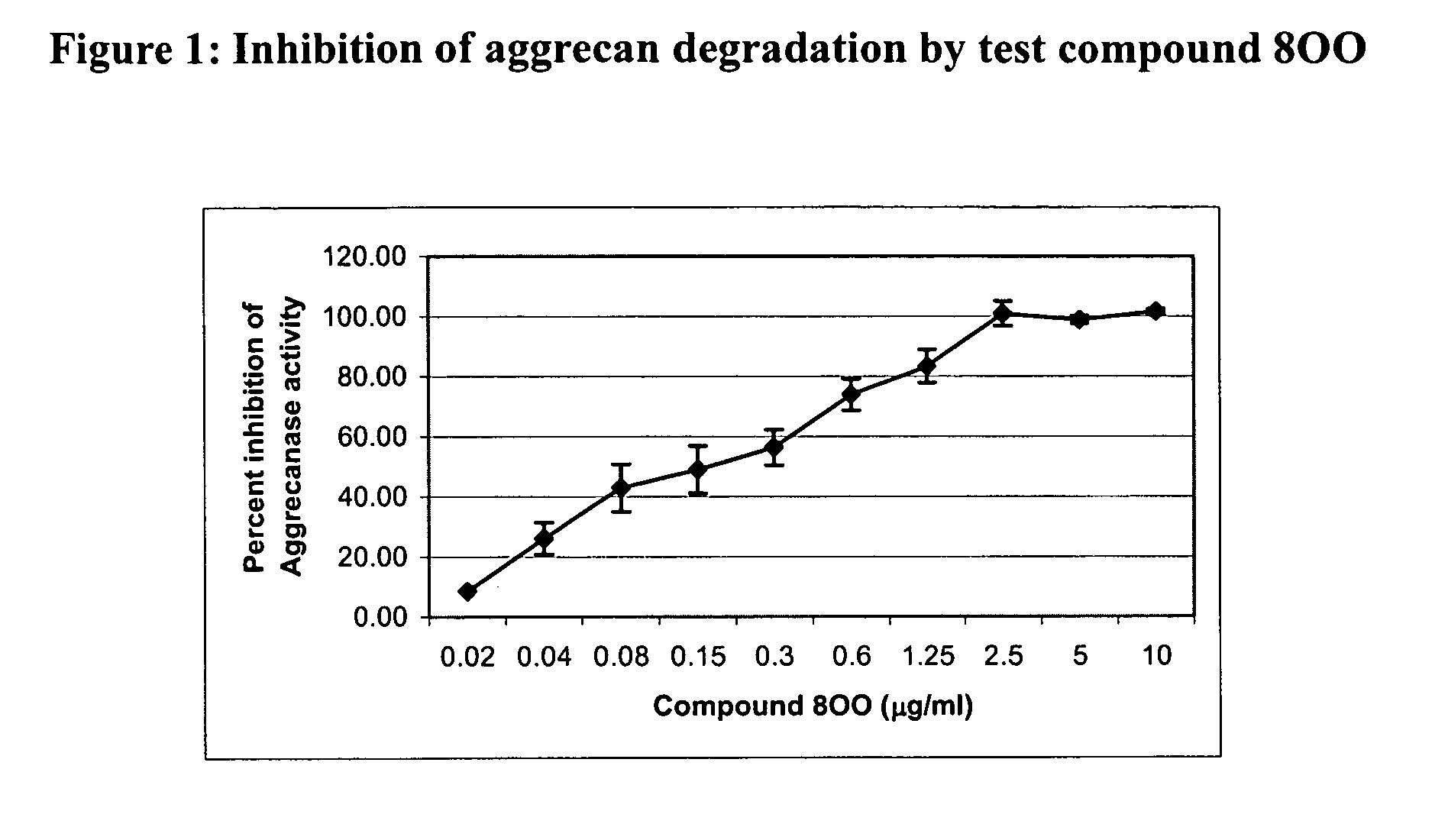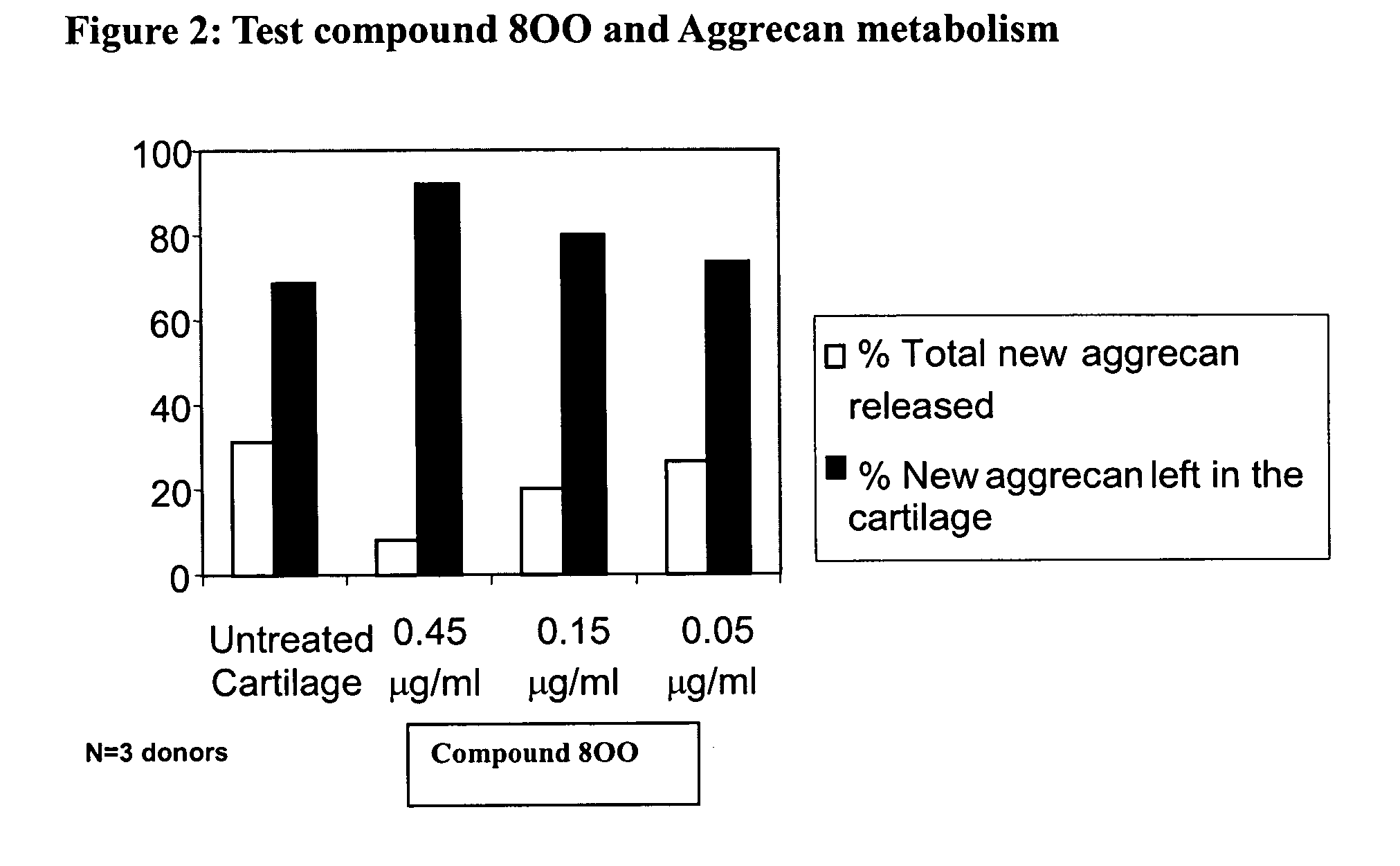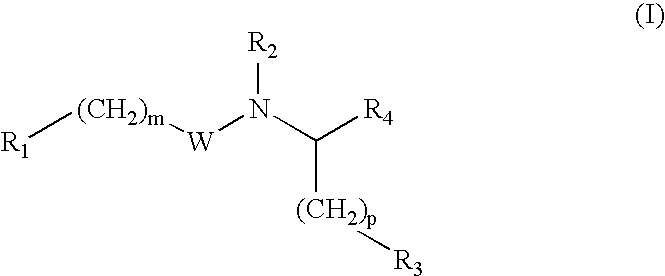Glutamate aggrecanase inhibitors
a glutamate aggrecanase and inhibitor technology, applied in the field of compounds, can solve the problems of severe reduction of quality of life and deficiencies in the biomechanical characteristics of cartilag
- Summary
- Abstract
- Description
- Claims
- Application Information
AI Technical Summary
Benefits of technology
Problems solved by technology
Method used
Image
Examples
example 1
N-[4-(pyrimidin-2-ylamino)benzoyl]-L-glutamic acid
[0321]
[0322]Step A: 2-[4-(pyrimidin-2-ylamino)-benzoylamino]-pentanedioic acid diethyl ester
[0323]2-Chloropyrimidine (0.72 g, 6.3 mmol) and N-(4-aminobenzoyl)-L-glutamic acid diethyl ester (2.04 g, 6.3 mmol, 1 equiv.) were dissolved in DMF (4 mL) and the resulting mixture was heated to 110° C. for 3 hrs. Reaction was complete as determined by TLC. The mixture was cooled to room temperature and partitioned between ethyl acetate and water. The organic phase was washed with brine, dried over MgSO4, and concentrated by rotavap. The residue was purified by column chromatography (silica gel, 50% EtOAc / hexane) to afford 1.75 g of desired product 2-[4-(pyrimidin-2-ylamino)-benzoylamino]-pentanedioic acid diethyl ester in 69% yield. MS (ESI) m / z 399.
[0324]Step B: N-[4-(pyrimidin-2-ylamino)benzoyl]-L-glutamic acid
[0325]A solution of 2-[4-(pyrimidin-2-ylamino)-benzoylamino]-pentanedioic acid diethyl ester (250 mg, 0.62 mmol) in THF (4 mL) was a...
example 2
N-(1,1′-biphenyl-4-ylcarbonyl)-D-glutamic acid
[0327]
[0328]Step A: 2-[(Biphenyl-4-carbonyl)-amino]-pentanedioic acid diethyl ester
[0329]A solution of 4-biphenylcarboxylic acid (670 mg, 3.4 mmol) and (809 mg, 3.4 mmol, 1 equiv.) in dry DMF (20 mL) was added to EDCI (801 mg, 5.1 mmol, 1.5 equiv.), triethylamine (853 mg, 8.4 mmol, 2.5 equiv.) and DMAP (82 mg, 0.7 mmol, 20%). The mixture was stirred at room temperature overnight. Reaction was complete as determined by TLC. The mixture was diluted with EtOAc and washed with H2O, brine, and dried over magnesium sulfate. Solvent was removed and the residue subject to column chromatography (silica gel, 50% EtOAc / hexane). 660 mg of desired product 2-[(Biphenyl-4-carbonyl)-amino]-pentanedioic acid diethyl ester was isolated in 51% yield. MS (ESI) m / z 382.
[0330]Step B: N-(1,1′-biphenyl-4-ylcarbonyl)-D-glutamic acid A solution of 2-[(Biphenyl-4-carbonyl)-amino]-pentanedioic acid diethyl ester (250 mg, 0.65 mmol) in THF (6 mL) was added to MeOH (...
example 3
N2-[4-(pyrimidin-2-ylamino)benzoyl]-L-alpha-glutamine
[0332]Step A: 4-Carbamoyl-4-[4-(pyrimidin-2-ylamino)-benzoylamino]-butyric acid tert-butyl ester
[0333]4-(Pyrimidin-2-ylamino)-benzoic acid (1.80 g, 8.4 mmol, 1 equiv.) and EDCI (2.41 g, 12.6 mmol, 1.5 equiv.) were dissolved in DMF (60 mL) under N2. The mixture was stirred at room temperature for 20 minutes, followed by the addition of H-Glu (OtBu)-NH2 (2 g, 8.4 mmol, 1 equiv), Et3N (2.92 mL, 20.9 mmol, 2.5 equiv.), and DMAP (0.512 g, 4.2 mmol, 0.5 equiv). The mixture was allowed to stir at room temperature overnight. Reaction was complete as determined by TLC. DMF was removed by rotovap and the residue was dissolved in EtOAc. The organic layer was washed with brine and dried over MgSO4. Most of the solvent was removed by rotavap and a solid was precipitated from the mixture during solvent evaporation. The solid was collected by filtration and washed with EtOAc. 823 mg of 4-Carbamoyl-4-[4-(pyrimidin-2-ylamino)-benzoylamino]-butyric...
PUM
 Login to View More
Login to View More Abstract
Description
Claims
Application Information
 Login to View More
Login to View More - R&D
- Intellectual Property
- Life Sciences
- Materials
- Tech Scout
- Unparalleled Data Quality
- Higher Quality Content
- 60% Fewer Hallucinations
Browse by: Latest US Patents, China's latest patents, Technical Efficacy Thesaurus, Application Domain, Technology Topic, Popular Technical Reports.
© 2025 PatSnap. All rights reserved.Legal|Privacy policy|Modern Slavery Act Transparency Statement|Sitemap|About US| Contact US: help@patsnap.com



